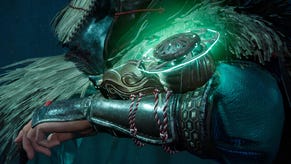Wild Hearts: a potentially great game impacted by tech issues on all platforms
PS5, PC and Xbox Series versions tested.
Developed by Japanese studio Omega Force, Wild Hearts is an entirely new action RPG with more than just a passing resemblance to Capcom's Monster Hunter series. There's no disguising Wild Hearts' inspiration here: you accept missions, track down colossal beasts roaming the land and you battle through day and night, alone or in online co-op, until your target is slain. Beyond that, you scavenge their remains, mine the environment for resources and forge even higher-stat weapons and armour to take on even tougher foes. What sets this game apart is its target hardware: Wild Hearts targets current-gen consoles and PC only, whereas Monster Hunter is firmly addressing older gaming hardware. This gave me plenty of optimism going into reviewing the game - but it's clear that despite some laudible ambition here, every version of the game has technical issues in some form that must be addressed.
Developed using the Katana engine - a newly branded tech from Koei Tecmo - there's no denying the quality of Wild Hearts' art direction. The icy tundras of its opening tutorial, the shrines of the Minato hub area and the coral reefs of Natsukodachi Isle offer a wealth of variety. There's a rich colour palette to every biome, with a rolling time of day, procedural cloud generation, and physics-based elements.
The concept art behind each Kemono is brilliantly translated in-game, too. Every one is a spectacle, covered in climbable fur - Shadow of the Colossus-style - and at times even a tangle of vines and petals. These are walking, breathing hybrids of plant and mammal, flora and fauna, that morph into multiple forms, dragging you to different sections of the map. The combat lands brilliantly too: every strike delivers a satisfying crunch and snap, punctuated by heavy effects and shader-work. Plus there's the ability to build objects, crates, springs, barriers on the fly to transform the battlefield. And in fact, PS5 sweetens the deal with a very light use of adaptive triggers for the final blow.
It's hard to overlook Wild Hearts' visual shortfalls, however. Firstly, texture-work doesn't hold up to scrutiny when viewed up close. Even on PS5 or Series X, asset quality for moss, wood, and brickwork use distractingly low resolution maps at times. Additionally, Xbox Series S uses even lower resolution textures than the premium consoles, producing some glaringly blurry surfaces. You may not notice in the heat of the action, but in getting from A to B there are some obvious rough spots. Likewise, the method of screen-space reflections (SSR) is of a low quality for all three machines: it's a flickering, pixellated, low resolution mirror image, with a huge gap around occluding objects. Again, Series S gets a particularly raw deal here, with an even lower accuracy setting than PS5 or Series X.
Shadows are also problematic. On PS5, Series X and especially Series S, you'll notice global shadow maps are missing entirely at times for certain elements in the scene. Even ambient occlusion disengages on PS5, Series X and S occasionally, all of which means that fields of flowers go unshaded. They're raw, and don't blend properly into the scene, creating a visual clash - a stark contrast, a disconnect between the geometry, materials, and these transparent elements. It doesn't end there, either: shadow pop-in is another huge issue in general, with world shadow maps visibly flickering on and off based on your camera viewpoint.
These issues undermine some of the strong art direction in Wild Hearts - and there's more still to touch on. Regardless of console, the TAA method produces some of the worst motion banding I've seen in recent memory. Any time your weapon overlaps with detail-dense textures you'll see banding. Even more glaring is the way TAA combines with sub-pixel elements - like bushes in the distance - instantly turning just these elements into a blurred mess. Additionally, Wild Hearts' motion blur, enabled by default, has a bug as of current patch 1.02. It appears on PS5, Series X and S, making a small nudge to the camera during the snowy tutorial section instantly blur the screen, like a vaseline filter. Even at its best, I found the blur's rather heavy impact makes the action harder to read. Thankfully, you can turn it off, which is my first recommendation when playing the game.

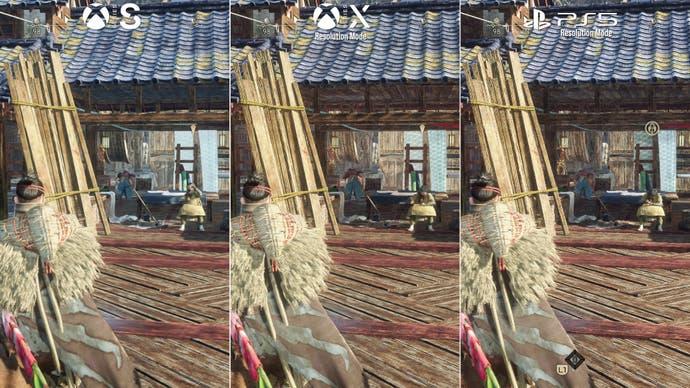


In terms of visual modes and features, we have two options on PS5 and Series X. There's a resolution mode targeting a native 4K at 30 frames per second - and this does genuinely hit a native 3840x2160 in some pixel counts. However, there also appears to be a dynamic element to this. In some cases, one or both of the axes of the 4K pixel structure halve - leading to 1920x2160 or 1920x1080 as the base image in taxing areas. It's often masked by the TAA - and honestly, the result never looks as sharp as it could.
Meanwhile, there's also a performance mode on PS5 and Series X. This is my recommendation for play, just for sheer playability - even though it comes at a cost of a native 1080p resolution. The caveat is that cutscenes still lock at 30fps in the performance mode, and they continue rendering at 1080p regardless. It's hardly the next-gen dream but for an action RPG, I'd prioritise 60fps all the way. Otherwise, settings between the modes are the same. Reflections, foliage density, shadow quality, draw distance for geometry - all stay in place between the modes. It's just resolution and frame-rate targets that change.
Suffice to say, PS5 and Xbox Series X get both modes - and yes, the visuals are broadly speaking identical across the two premium machines. The catch is, there are two huge exceptional points that favour each machine. First up, it's bad news for PS5 users. At least as of patch 1.02, there's a bug affecting image quality on PS5 - not present on Series X or S - causing its pixel structure to flicker constantly on its 4K resolution mode. This pixel crawl artefact affects some areas more than others, sticking out most glaringly around the Minato hub shrine. Even while stood perfectly still, in fact, any long high contrast edges tend to flicker aggressively. It's almost as if there's an issue with the upscale to PS5's 4K mode, as it switches between different resolutions values.
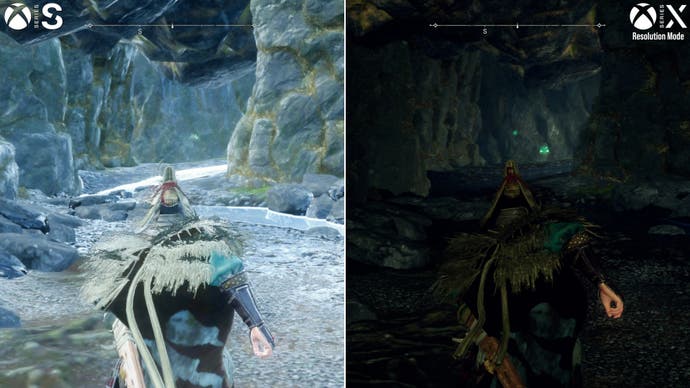
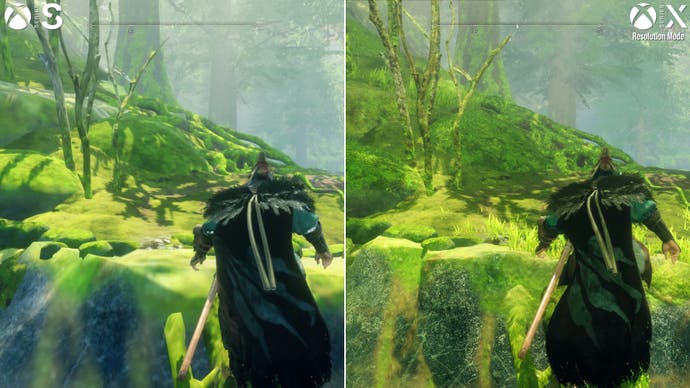

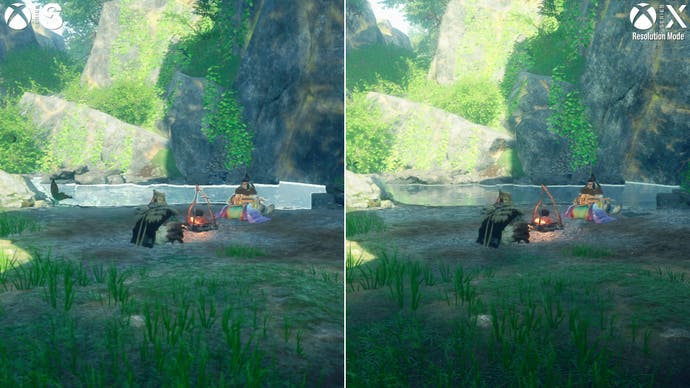
Comparing PS5 to Series X directly, the result is a temporally unstable image on Sony's machine in spots - in the resolution mode at least. Fortunately, the opening areas before reaching the hub don't make the pixel crawl bug evident at any point. And to be clear, there is a workaround. If we switch over to its 1080p 60fps performance mode, the issue is cleared up on PS5 - and image quality matches Series X. So, all signs point to a bug on PS5 that requires fixing.
The second issue concerns dialled back ambient occlusion on Series X. You may have spotted it in the shots above, but Series X has cutbacks in ambient shading in specific spots, stripping the scene of some much-needed depth. Be it around the opening woodland tutorial, or even the shrine interiors, shading is at times removed entirely on Series X for objects - creating a visibly lighter appearance - while for other areas it's maintained. This applies regardless of if you use the performance or resolution mode on Series X, so there are no workarounds in this case.
All of which leads us to the Series S situation. I'll be very blunt here and say that Series S is very hard to recommend right now. The visual cutbacks and lack of any mode toggle between 30fps and 60fps are hugely disappointing. You get just one way to play instead: at 30 frames per second, running at a native 1600x900 resolution. The upside is there's no flickering pixel crawl artefacting as with PS5, but that's not enough to save it. Comparing to Series X in its resolution mode, there are several key drawbacks, the first being the texture resolution. Series S uses lower resolution assets for areas of terrain, creating a blurry, soup-like result. It's barely to the standards of a last-gen Xbox One release at times.
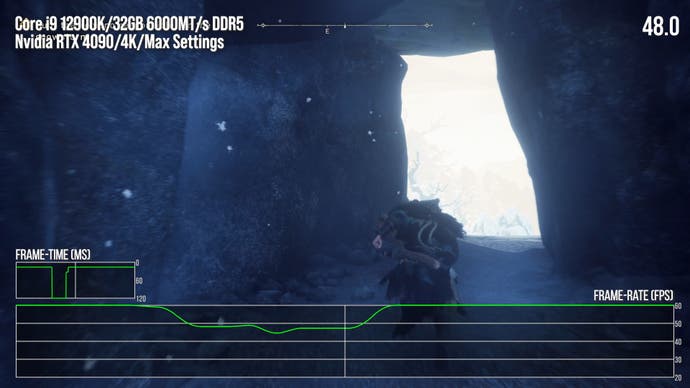
The second stark drawback to Series S is the absence of ambient occlusion. It's stripped back significantly further than Series X in select scenes, which in itself is already pared back next to PS5. So, for Series S, what this means is that entire environments are entirely unshaded - like caves, or building interiors - leaving a raw, bright, flat looking result. Added to that, there are further cutbacks on Series S, with pared back reflection quality and shadows. Wild Hearts' global illumination setting is also potentially affected on Series S here based on the above shots, creating a plainer, less vibrant result.
We didn't spend much time with the PC version owing to massively obtrusive stutter that typically sits within a 100-200ms window even on an RTX 4090 machines paired with a Core i9 12900K and fast DDR5. Omega Force has promised performance updates are coming though, alongside DLSS and FSR support - so there is hope on the horizon for PC. Sadly though, it's difficult to fathom how the developer thought the PC version was fit to ship at launch.
Jumping over to console performance, PS5's 30fps resolution mode is very straightforward: it's a locked v-synced 30fps experience with scarcely any sign of frame-pacing issues, so if you want a locked, stable frame-rate, this is the way to go. The drawback being, of course, that PS5 suffers from pixel crawl artefacting in this mode - which isn't an issue on the 60fps performance mode. PS5 runs without issue otherwise with barely a hitch or hiccup across my hours of play at 30fps.
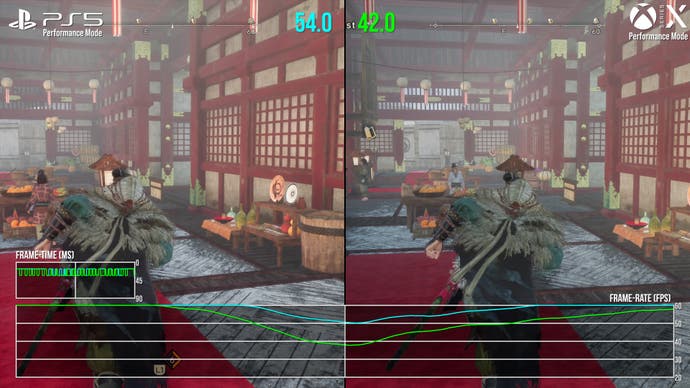
Moving over to Series X's own 30fps mode, we have an issue. Certainly, it lacks the pixel crawl issue, but instead has uneven frame-pacing with frame-times oscillating between 16, 33 and 50ms, causing the perception of frame-rate drops - even if there are none. It's a classic problem for 30fps caps: triggering more-so with any fast action, and movement across the terrain. Another factor here is the higher rate of visible frame-time spikes on Series X - especially around the shrines. These tend to go spike to up to 160ms, just as certain lighting affects engage, which again isn't an issue on PS5.
The 30fps cap on Series S has the same issue. Frame-times bounce up and down and it never feels especially smooth in motion. The real sting in the tail is that 30fps is really all you've got on this 4TF machine: one mode at 30fps with no alternatives. So, stacking on top of the long list of visual downgrades, having uneven frame-pacing makes Wild Hearts on Series S even harder to recommend. And it's a shame, because the actual stability of the frame-rate is largely on-point. It's not dropping to any obvious GPU or CPU strain during battle, or taxing areas. The junior Xbox is a clear disappointment then and it's a shame 60fps wasn't at least offered as an option - even with drops, where a VRR display might have helped.
Performance mode on Series X and PS5 is the way to go. Yes, it's a native 1080p but the upside is it's a more playable experience overall. That said, it's far from perfect. On PS5 and Series X alike, expect a bulk of open-world roaming to run at 60fps with some minor drops. The first island you're exposed to is the biggest stress test by far, however: lots of foliage, complex geometry, and huge Kemono bosses spewing effects across the scene. This shows us some bottlenecks, putting us between 40 and 60fps on PS5. Adding extra ally players into the mix gives us the lowest reading here too, in bumping up the frequency of effects on-screen. On the plus side, the Minato hub, and the second island starting at the shoreline, really don't drop to nearly the same extent. Even with its issues, for PS5 users this is a clear preference, with or without a VRR display.
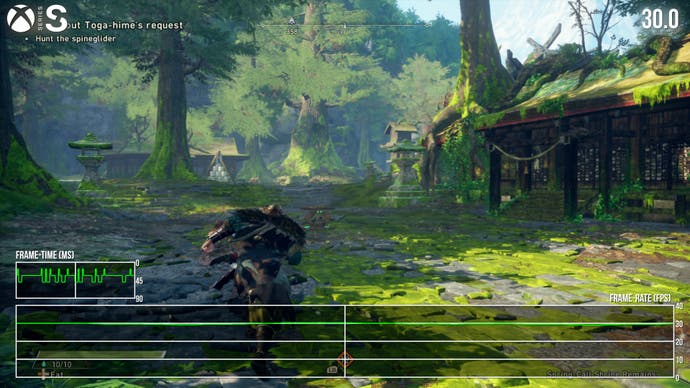
The state of Series X in its own performance mode mirrors PS5 fairly closely. Again, it's mostly 60fps and again, the climax to battles on the first island tip us over to the biggest drops, down to the low 40s. It's far from ideal but in like-for-like testing - charging through the temple at pace, for example - it seems that PS5 does actually run at a higher average frame-rate overall (at least for this section) with a 10-12fps advantage at best in PS5's favour. Outside in the wilderness, there isn't such a perceptible gap in usual play. So, again for Series X, the turnout for 60fps play isn't spectacular. It still needs work, with the drops hitting hardest during action, but it's a clear upgrade over the uneven 30fps in the other mode, and with some help from VRR it's salvageable.
The technical issues in Wild Hearts are such a shame, because I think there's so much potential in the game even with its various problems. There's a lot to enjoy here with the lavish world design, the superb combat and the object creation system. The parallels with Monster Hunter are clear in its mission design but the extra steps developer Omega Force takes to make the game excel visually - and mechanically - give it an identity beyond Capcom's work. Its focus on newer PS5, Series X and S systems is also commendable, given so many developers are still reluctant to stray from cross-gen projects.
Sadly though, there are a number of visual bugs that need addressing, while the ambition of its ideas - the huge, complex Kemono creatures especially - are a drain on performance for even PS5 and Series X. The Series S version is in particular need of attention here. I can only hope that Omega Force isn't done with this game. It's obvious that the PC version's launch experience is unacceptable, but I'd also hope to see resources sunk into getting the console versions into shape too.








